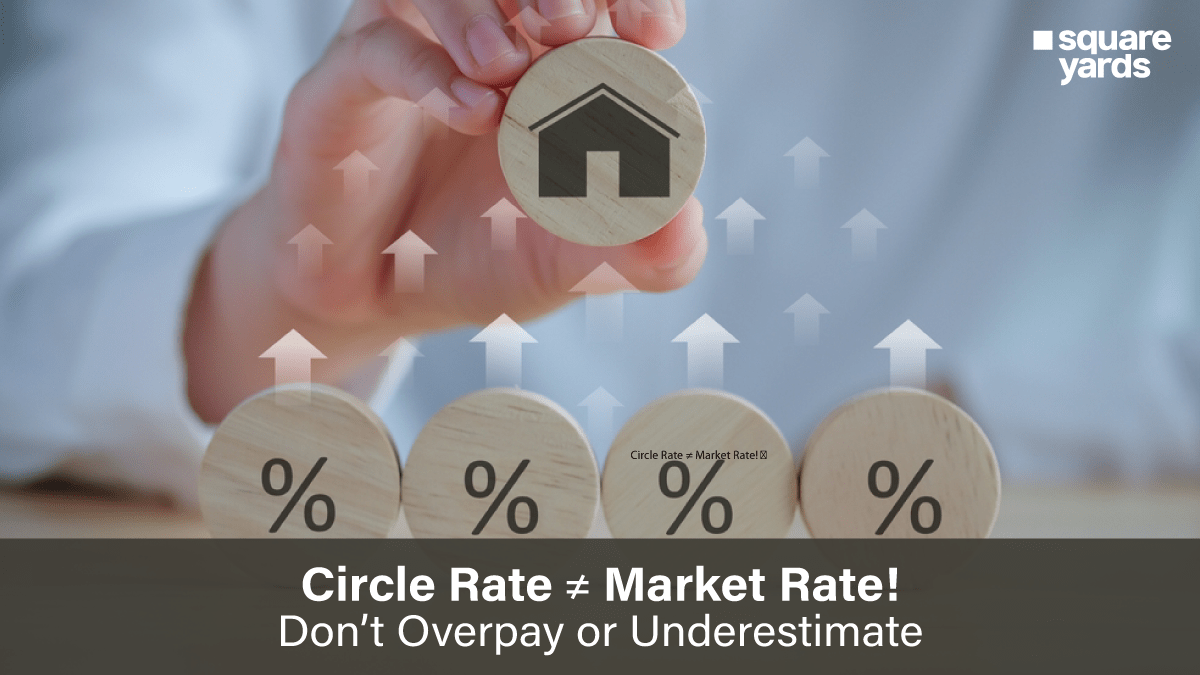Buying property is not just about location, builder reputation, or fancy amenities. It is also about understanding the numbers that dictate its real worth. And one of the most important yet overlooked figures in real estate transactions is the circle rate. Set by the government, this baseline property price directly impacts stamp duty, registration charges, and loan eligibility. With Circle Rate 2025 rolling out, buyers and investors must stay sharp because even a small change can make a big difference in property costs.
So, what’s new in 2025? Are rates rising or stabilising? How does it affect homebuyers and sellers? Knowing the updated circle rates could be the key to making a smarter purchase if you are planning to invest or are already in the middle of a deal. Let us break it down, no jargon, just the facts you need to know before sealing the deal.
Table of contents
What is Circle Rate
The circle rate is the minimum property price the government sets for different localities. It is used to calculate stamp duty and registration charges during property transactions. The rate ensures fair taxation and prevents the undervaluation of property deals. Also known as guideline value or ready reckoner rate, it varies based on location, property type, and market conditions.
While market rates fluctuate due to demand and supply, circle rates provide a standardised benchmark. If a property's sale price is lower than the circle rate, taxes are levied on the higher value. Conversely, if the market price is higher, stamp duty is still calculated on the government-set rate.
Governments periodically revise these rates to align with real estate trends, impacting buying costs and investment potential. Understanding circle rates helps buyers and sellers make informed decisions while avoiding tax complications.
How is the Circle Rate Calculated?
The Circle Rate (Guidance Value, Ready Reckoner Rate, or Collector Rate) is the minimum value at which a property must be registered with the government. The local authorities set it, which varies based on location, property type, and other factors.
Local authorities determine the Circle Rate based on multiple factors, including:
- Location & Demand – Prime areas have higher circle rates than less developed areas.
- Property Type – Residential, commercial, and agricultural lands have different circle rates.
- Property Use – Whether the property is vacant land, an apartment, an independent house, or a commercial building.
- Construction Cost & Amenities – The quality of construction and the availability of amenities (e.g., elevators, parking, and a clubhouse) influence the rate.
- Market Trends – Authorities consider recent property transactions and market price fluctuations.
- Government Policies & Revisions – Circle rates are revised periodically based on government policies and inflation.
Formula for Circle Rate Calculation
Although not standardised across all regions, a basic way to estimate the circle rate of a property is:
Circle Rate= Minimum Rate per sq. ft. or sq. meter× Property Area
For example:
If the circle rate for a locality is ₹5,000 per sq. ft. and the property size is 1,000 sq. ft., the minimum property value for registration would be:
5,000×1,000= ₹50,00,000
What is the Market Rate?
The market rate refers to the actual price at which a property is bought or sold in the open market. Unlike the circle rate, set by government authorities as a benchmark for property registration and taxation, the market rate is driven by real-time demand and supply fluctuations. Several critical factors influence this rate, including location, property condition, available amenities, infrastructure development, and overall economic trends.
In areas experiencing high demand, such as prime urban centres with excellent connectivity, commercial hubs, and social infrastructure, the market rate tends to be significantly higher than the circle rate. Buyers are willing to pay a premium for properties in such locations due to their potential for capital appreciation and rental yield. On the other hand, in less developed or low-demand regions, market rates may be closer to, or in some cases even fall below, the circle rate, especially if there is an oversupply of properties or limited buyer interest.
Market rates are inherently dynamic and vary even within the same locality. Factors such as the builder’s reputation, property age, floor level, and future development prospects can cause variations in pricing between similar properties in a neighbourhood. Additionally, buyers and sellers negotiate based on current market conditions, financing options, and investment potential, leading to fluctuations in the final transaction value. Due to these market-driven influences, the market rate is generally higher than the circle rate, making it a more accurate representation of a property's real-world value. Understanding these variations is essential for making informed real estate decisions, whether buying, selling, or investing in property.
Important Key Factors about Market Rate
Several key factors influence the market rate of a property. Here are the key elements that impact it:
- Demand & Supply: Higher demand in a locality pushes property prices, while oversupply lowers them.
- Location and Infrastructure: Property value increases with proximity to metro stations, commercial hubs, and social infrastructure (schools, hospitals).
- Property Type & Condition: Apartments, villas, and commercial properties have different valuation trends. Well-maintained or newly constructed properties fetch higher prices.
- Comparable Sales (Recent Transactions): The rates of recently sold properties in the same area help estimate the current market value.
- Economic Factors: Inflation, interest rates, and economic growth affect real estate prices.
- Investor Sentiment and Market Trends: When real estate is booming, market rates rise; during downturns, they drop.
Difference Between Circle Rate and Market Rate
Below is a detailed comparison highlighting the key differences between the circle rate and the market rate:
| Aspect | Circle Rate | Market Rate |
| Definition | The minimum price at which a property must be registered with the government. | The price at which a property is bought or sold in the open market. |
| Determining Authority | Set by state governments or local authorities. | Determined by real estate market conditions and negotiations between buyers and sellers. |
| Price Flexibility | Fixed for a certain period and revised periodically. | Fluctuates frequently based on demand and supply. |
| Value Difference | Usually lower than the market rate. | Higher than the circle rate, except in low-demand areas. |
| Purpose | Used for calculating stamp duty and registration charges. | Determines the actual transaction value of the property. |
| Basis of Calculation | Based on past government records, development plans, and taxation policies. | Based on current demand, location, infrastructure, amenities, and property condition. |
| Influencing Factors | Government regulations, inflation, and land categorisation. | Market trends, buyer demand, economic conditions, and investor confidence. |
| Impact on Transactions | Determines the minimum taxable value of a property. | Reflects the real-time price at which a property can be bought or sold. |
| Impact on Real Estate Investment | Ensures properties are not undervalued for tax purposes. | It helps investors and homebuyers assess the real worth of a property. |
Other Cities Circle Rate
| Circle Rate in Noida | Noida Circle Rate |
| Circle Rate in Gurgaon | Gurgaon Circle Rate |
| Circle Rate in Delhi | Delhi Circle Rate |
| Circle Rate in Mumbai | Ready Reckoner Rate in Mumbai |
| Circle Rate in Bangalore | Bangalore Circle Rate |
Comparison of Circle Rate and Market Rate of Top Indian Cities
In India's real estate market, circle rates and market rates often differ across various cities, reflecting disparities between government-assessed property values and actual market valuations. Here's a comparison of these rates in some of the top Indian cities:
| City | Circle Rate (per sq. ft.) | Market Rate (per sq. ft.) |
| Delhi | ₹8,858 | ₹1,37,247 |
| Mumbai | ₹21,645 | ₹1,83,711 |
| Bangalore | ₹28,344 | ₹72,270 |
| Kolkata | ₹4,912 | ₹55,996 |
| Hyderabad | ₹3,928 | ₹57,972 |
| Chennai | ₹2,000 (Guduvancherry) | ₹51,108 |
Note: The above rates are approximate and can vary significantly within different localities of each city. Circle rates are subject to periodic revisions by state governments, and market rates fluctuate based on demand and supply dynamics.
FAQ's about Circle Rate
The circle rate calculates a property's value by multiplying the government-set rate per sq. ft. or sq. meter by the total property area. For example, if the circle rate in a location is ₹5,000 per sq. ft. and the property is 1,000 sq. ft., the minimum property value for registration would be:
₹5,000 × 1,000 = ₹50,00,000
This value determines stamp duty and registration charges, ensuring properties are not undervalued for taxation purposes. No, a property cannot legally be sold below the circle rate because the stamp duty and registration charges are calculated based on this government-mandated minimum value. Even if the transaction happens at a lower price, the buyer must pay the responsibilities according to the circle rate value, ensuring transparency and preventing tax evasion. If the market rate is lower than the circle rate, the buyer must still pay stamp duty and registration charges based on the circle rate, per government regulations. Under tax laws, the difference between the circle rate and the actual transaction value may be considered "income from other sources," leading to additional tax liabilities for the buyer and seller. The circle rate in India is decided by the state government and is implemented by local authorities such as the Revenue Department, Municipal Corporations, or Development Authorities. It is periodically revised based on property transactions, market trends, and infrastructure development. Q1. How does the circle rate calculate property value?
Q2. Can you sell a property below the circle rate?
Q3. What if the market value is less than the circle rate?
Q4. Who decides the circle rate in India?




